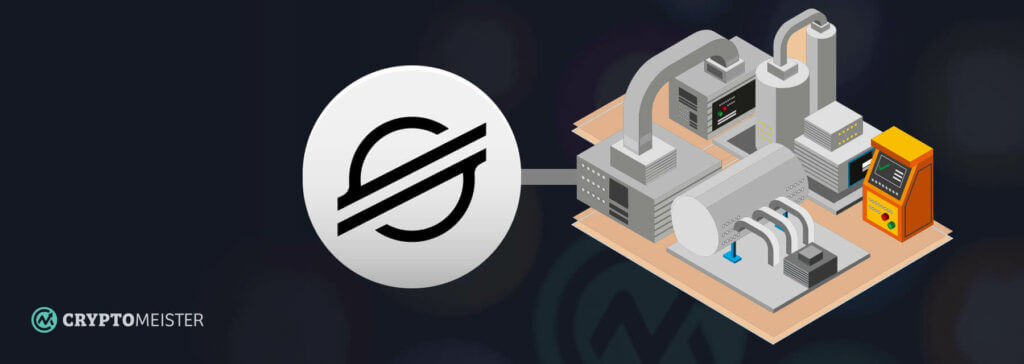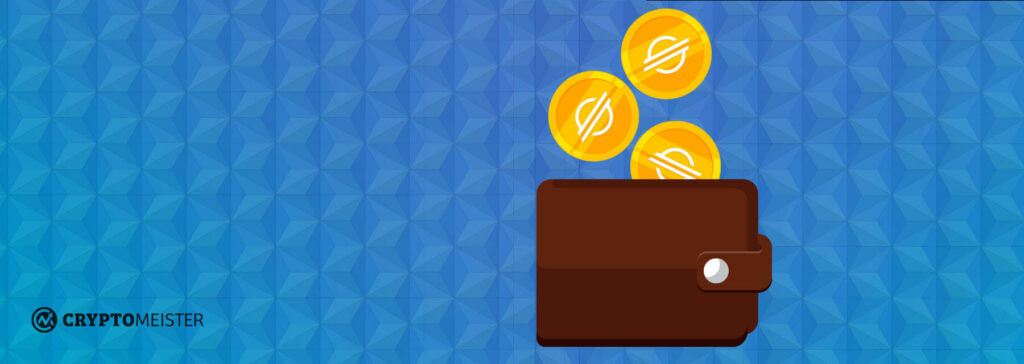
Binance
Only for verified users
Stellar was founded in 2014 and is one of the most traded cryptocurrencys on the market today. Learn everything you need to know about Stellar with our detailed guide and discover the best crypto exchanges where you can buy Stellar!

Only for verified users



Stellar is something of an OG in the crypto space, having been launched in 2014 by Jed McCaleb, one of the minds behind another blockchain, Ripple, with which it shares many similarities.
Like its cousin, the Stellar blockchain was designed to be a fast, open-source, decentralized payments network, with users able to send the proprietary coins, called Stellar Lumens (XLM), to each other at a fraction of the cost of a traditional money transfer. In this piece we look at what the Stellar project is, how it works, and how to buy XLM tokens.
Before we talk about how you can buy Stellar we’ll take a look at how this cryptocurrency actually works. Many people believe that the Stellar crypto project is a ‘fork’ of Ripple, in the same way that Bitcoin Cash is a fork of Bitcoin.
However, despite sharing many similarities, this is not the case. This is because the two systems operate on different blockchains rather than Stellar’s blockchain being a direct derivation of Ripple.
Stellar founder Jed McCaleb is not just the man behind the Stellar crypto project. He’s also the creator of Mt. Gox, the famous Bitcoin exchange that blew up in 2014, years after McCaleb had sold it to work on Ripple.
McCaleb and another man, Chris Larsen, bought an existing project called RipplePay in 2012 and rebranded it as Ripple, before the two parted ways in 2014 after a disagreement over the future of the protocol.
McCaleb took his vision, and the basis behind Ripple’s technology, and formed Stellar and Stellar Development Foundation, which would oversee development of the protocol.
Where Ripple was focused on providing a solution to financial institutions, the main idea behind Stellar was to provide fast and cheap international money transfers for everyday people, particularly those in the world’s unbanked or underbanked population.
Initially this was just through the proprietary XLM cryptocurrency, but as time has passed this has expanded to many other cryptocurrencies, opening it up to some truly groundbreaking partnerships that could usher in a new age in digital asset adoption.

Having been around for many years, there are plenty of places where you can buy XLM tokens. Here is a rundown of the top places you buy Stellar Lumens:
Binance is the biggest cryptocurrency exchange by volume in the world. It launched in September 2017 with XLM as one of its first coins, and you can still buy it there. Binance has six XLM trading pairs:
You can also buy Stellar tokens on Binance with a debit card in one of many fiat currencies.
Coinbase is one of the oldest exchanges in the crypto world, and remains one of the most used. Coinbase added support for XLM in September 2019, and supports the following pairs:
Like Binance, you can also buy XLM through a debit card in a range of fiat currencies, and you can even fund your account through a bank transfer and buy Stellar Lumens that way.
eToro is a popular trading platform that has come to cryptocurrencies a bit later than others, and only recently allowed users to withdraw their coins – if they meet certain criteria. eToro added XLM as a base trading pair in August 2019, making it tradeable with eToro’s own stablecoins, alongside BTC:
StellarX is Stellar’s own decentralized exchange that allows you to use traditional fiat currencies to pick up XLM tokens. You’ll need to register with an email address, and the exchange will create a wallet for you, but once you’re over these hurdles you can buy XLM tokens for one of a number of currencies and then withdraw them to a Stellar wallet of your choice, should you wish.
StellarX has dozens of XLM pairs, including cryptocurrencies and fiat currencies, meaning you can almost take your pick. However, volume isn’t great on the less commonly used pairs, which tend to be crypto-XLM pairs.
There are a number of other exchanges where you can buy XLM tokens, but please do your own research to find which is the most suitable for you before you register with them. One place you won’t be able to buy Stellar Lumens is on mainstream decentralized exchanges, as XLM is not a DeFi coin.
There are a number of ways you can pay for XLM tokens if you want to pick some up, but here are the the most common ones:
If you already hold cryptocurrencies in a wallet or on an exchange, the chances are you’ll be able to swap them for XLM pretty easily. XLM can be readily swapped with popular stablecoins such as USDT on dozens of exchanges, while many also allow XLM to be swapped for cryptocurrencies such as BTC and ETH.
This means that even if you don’t hold those cryptocurrencies themselves, you can easily swap over to them and buy your XLM that way.
Many exchanges allow their users to buy XLM with a credit card or debit card, as long as their bank supports crypto purchases. Buying XLM tokens this way is very similar to buying anything online, although it’s best to check with your bank whether the transaction might be blocked before you try.
Once you have registered/logged into your exchange of choice, simply click or tap the ‘buy’ option. This is typically located on the exchange’s homepage, so you can’t miss it. Enter the fiat value of the XLM you want to buy and go through the steps to complete the payment (beware of processing fees). Once your XLM purchase has been approved, it is advisable to withdraw it from the exchange to your wallet, but this is not essential.
Not all banks allow cryptocurrency purchases, but if you find this route being blocked there is another way – bank transfers. Many top exchanges will allow you to fund your account through a bank deposit, which in most instances doesn’t carry the same restrictions as a bank card.
Once you’ve created your account or logged in, follow the ‘deposit’ or ‘buy’ link and you’ll be given the payment options available to you. If the exchange supports bank transfers it will give you the details (make sure you note the reference so that it ends up in your account!), which you can use to send your funds over.
If you intend to use this method, it’s advisable to perform a small test transfer to make sure it goes through okay before you send the full amount you want to spend.

Stellar runs on its own protocol – the Stellar Consensus Protocol (SCP) – which is a decentralized network of ‘nodes’.
You can think of SCP as Stellar’s algorithm to verify transactions, with Stellar Core being the software that allows them to do it. Transactions are very fast, with coins changing hands in around 4-5 seconds and for a set fee of 0.00001 XLM (one XLM is worth $0.12 at the time of writing).
The nodes in the Stellar crypto network all help to validate and process transactions, ensuring that no fraudulent transactions can slip through. Anyone can run a basic Stellar node on their own computer, as long as it can run the Stellar Core software and has a reliable internet connection.
There are three types of Stellar node you can run:
Validator nodes are important to the Stellar network – the more there are, the more robust and decentralized the network is. Unlike other blockchain networks, Stellar node operators are not rewarded for their participation in the proprietary token. Instead, their reward is the knowledge that they are helping secure the network.
The core reason for anyone to buy XLM tokens is to use them to send funds quickly and cheaply – after all, that’s what it was designed for! However, from an investment perspective, Stellar also has been making moves in recent years that point to it being a good bet for the long term.
In October 2021, Stellar signed a deal with remittance giant Moneygram to create a payment system that would see its blockchain used to ferry Circle’s USDC stablecoin worldwide for remittance payments. This deal was particularly sweet for Stellar because it came after Moneygram had scrapped a remittance deal with Ripple some months previously, and came on the back of Stellar’s plans to increase the scope of its offerings.
If this partnership bears fruit, it could lead to Stellar being seen as a blockchain for the future of crypto payments rather than being thought of, as it had been for a while, as an enterprise that had seen its better days. This could make buying XLM a smart move.

A Stellar crypto wallet is simply a digital wallet where you can safely store your XLM tokens. Stellar doesn’t have its own proprietary wallets, but on its website it recommends a number of third-party wallets for XLM holders to use.
Stellar crypto wallets come in two variations – software wallets and hardware wallets. Software wallets are those that are used on a computer, either as a standalone program or within a web browser, or a mobile device in the form of an app.
You can also store your XLM tokens in a hardware wallet. These are physical devices that look like USB keys and keep your XLM tokens offline when not being used.
Software wallets are generally considered the best for those that plan to use their XLM tokens more frequently, while hardware wallets are best for those that have large holdings or that plan to hold their tokens for a long time.
This is because wallets that utilize offline storage, like hardware wallets, are far harder to hack. Software wallets are generally free but hardware wallets are not, so it depends how much that extra peace of mind is worth to you.
When you send a transaction through the Stellar crypto network, it gets picked up by a Watcher node, which pushes the instruction forward to a Validator node. The Validator node then processes the transaction and asks the other Validator nodes for consensus that the transaction and its details are accurate.
Once enough the Validator nodes agree, the ledger is closed and your coins are sent. The update is then sent to the Archiver nodes, which publish the new ledger, with your transaction added, to all the nodes on the network.
This entire process takes just 4-5 seconds, after which time the XLM coins you send will be received.
Stellar has been through the good and bad when it comes to the crazy world of crypto, with its years in the space certainly allowing it to have an OG status. However, this longevity doesn’t make it flawless, and there are a few things you should look out for before you consider buying XLM:
Obviously, some of these issues are bigger concerns than others, but it’s important for you to weigh them up against each other when you consider buying Stellar tokens.
Stellar’s future plans are structured around three strategic building blocks:
To help reach these goals, Stellar has a number of plans in place. These include launching ‘Speedex’, a new type of Stellar-powered decentralized exchange; accelerating smart contract implementation; improving on- and off-ramps to expand growth; and expanding its network capabilities through native implementation, bridging, and partnerships.
As we know, these plans have already borne fruit with Stellar’s Moneygram/Circle partnership, and if Stellar can use this as a springboard for further partnerships then its future could be very bright indeed.
It’s hard to know where to place Stellar in the overall crypto space. On one hand its technology is hardly new, having been around since 2014, and its star has certainly waned as other blockchains have come on the scene.
It has hardly set the world alight in the years since its first block was produced, with the Moneygram/Circle deal being the first truly groundbreaking moment in its entire history.
On the other hand, Stellar has been trying to expand its services in recent years having realized that the personal remittance market wasn’t taking off, targeting companies to test out its tech to a captive audience.
It has succeeded in this with the Moneygram/Circle deal, and with its transaction costs still being so low and transaction times still beating even newer coins, we could well be witnessing the start of the Stellar revolution.
While Stellar’s new gambit isn’t exactly make or break, what happens over the next couple of years will go a long way to shaping its long term future.
In 2022 Stellar was chosen as the blockchain to host crypto payments through Moneygram in association with Circle, showing that it can still compete with newer blockchains.
It is also still a fixture on top exchanges worldwide, although outside of the Moneygram deal there isn’t a huge amount of adoption.Stellar is actually a fork of the Ripple (XRP) blockchain, which means that technically speaking the two are almost identical, although Ripple’s total coin count is twice that of Stellar (100 million compared to 50 million).
Ripple says it has numerous integrations with banks, whereas Stellar’s only major achievement has been its Moneygram deal, suggesting that Ripple has bigger adoption.